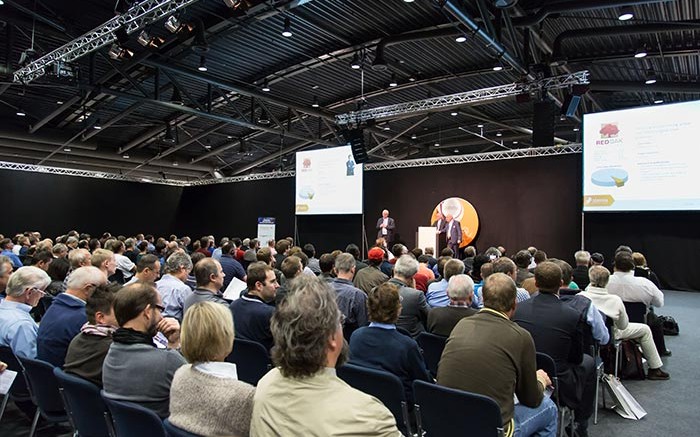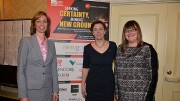MUNICH, GERMANY — Dave Hodge, the president of Zimtu Capital, has a public persona that transcends the Atlantic.
With an oration style that is part college football coach and part Baptist preacher, Hodge can jolt timid audience members in their seats with one of his trademark proclamations.
“The phrase is ‘buy low, sell high,’” he bellows to a packed room of some 500 investors and onlookers at the International Precious Metals & Commodities Show in Munich on Nov. 8. “Well guess what? Prices are now low!”
But Hodge is here to do more than simply embolden investors’ nerves against the slump in mining related equities. The stop in Munich is part of a 10-day, four-city jaunt through Germany and Switzerland that is intent on showing that his company — and the suite of mining juniors that Zimtu is invested in — are committed to the European investment community.
“Zimtu Capital came back to Munich again this year,” he says in a low rumble that foreshadows the push of volume yet to come. “And you have my guarantee that we will be back to see you next year as well, no matter what shape the market is in.” The last line is delivered as part of a rising crescendo complete with reddened face and glossy eyes that wills the crowd into a lusty burst of applause.
Five years ago Hodge and Red Oak Mining’s president and CEO, Jay Roberge, were sipping scotch in Hodge’s office — after work hours, of course — and talking about how to make a deeper connection with European investors.
The idea they stumbled upon was to take key executives from the exploration and mining companies that Zimtu incubates right to the doorstep of key investors in Continental Europe’s more important financial cities.
The two men realized any trip should be centered on the Munich show, since it was the biggest mining conference in Continental Europe. But branching out to other cities presented the logistical headache of corralling some 30 executives in a timely and efficient manner.
“What really has made it a success was the bus, when we hit upon that idea it just took off,” Hodge says of their plan to make the European expedition into a bus tour. “Whenever we’d mention the bus, people would stop asking silly questions like ‘how much was it going to cost?’ and would just say ‘I’m in.’”
This year marked the fourth year of the tour, but the first time that Frankfurt has been included. The financial capital of Germany played host to the opening investors conference that saw roughly 50 investors who had battled through a train strike to hear the presentations from 10 companies Zimtu invests in — all of which are mining related. Also on the docket were four non-mining related companies listed on the Canadian Securities Exchange (CSE). The CSE was the co-sponsor of the trip, along with Zimtu.
The first panel was moderated by House Mountain Partners founder and veteran newsletter writer Chris Berry, and included Prima Diamond’s president and CEO Robert Bick; Arctic Star Exploration’s director Thomas Yingling; and the president of Commerce Resources Chris Grove.
With two diamond executives on the panel, Berry began the discussion by asking Bick and Yingling to make the investment case for the precious stone.
While acknowledging the speculative nature of diamond exploration, Bick pointed out that the risk profile has, as one would expect, also yielded some of largest returns for investors able to pick the right plays.
On that front Bick argued that the locations of Prima’s properties are a prime reason for optimism around the company. It has diamond properties in the Northwest Territories near Canada’s most famed diamond mines Diavik, Ekati and Snap Lake, as well as Gahcho Kué, which should go into production in 2016 and is expected to be the largest new diamond mine in the world.
Just north of Gahcho Kué, Prima has its Munn Lake project, which hosts diamond-bearing kimberlite and diamond-bearing boulder fields, with four additional prospective kimberlites. It also has the Godspeed Lake property south of Munn Lake and the Orion properties in Quebec’s Otish Corridor just north of Stornoway Diamonds’ Renard project, which is also expected to go into production in 2016.
Being close to up-and-coming projects like Gahcho Kué and Renard has Bick confident that Prima is well positioned to be part of what he says could be the second phase of a diamond rush that was kicked off two decades ago by the Ekati and Diavik discoveries.
Yingling echoes Bick’s optimism with regards to a second diamond rush in the Great White North, and sees such a reinvigoration coinciding with improving fundamentals for the diamond market. That improvement will come as diamond jewellery demand increases with the emerging middle class in China, while mine supply dwindles.
“The major discoveries in the Northwest Territories were in the mid-nineties,” Yingling says. “That was twenty years ago, and they are now getting close to the end of their life cycle.”
Another advantage that favours Canadian diamond exploration and mining companies is the premium pricing enjoyed by Canadian diamonds due to their conflict-free status. Certified Canadian diamonds are laser engraved with a serial number, “gem-printed” and accompanied by a certificate of authenticity by the N.W.T. government that guarantees its Canadian origin.
Like Prima’s two projects, Arctic Star’s Redemption project is in the N.W.T. near Diavik and Ekati. Exploration costs are covered by its joint-venture partner North Arrow Minerals, which uses the same technology employed with great success by Kennady Diamonds to outline its nearby Kennady North project. The technology was originally developed for submarine detection, but has helped Arctic Star identify targets that it plans to drill early next year.
Moving away from the diamond duo of Bick and Yingling, Berry turned the focus to Commerce Resource’s Chris Grove. Berry pointed out that after a furious rush of investment activity a few years ago much of the lustre on the rare earth elements (REE) story has been lost, and asked Grove why investors should come back to the story.
Grove pointed to the REE metal dysprosium as a case in point. When stacked up against a price of US$2,400 per kg during the peak of the REE bull market three years ago, the current price in the US$450 range doesn’t look that enticing. But when that same US$450 price is benchmarked against the 2009 price for dysprosium — when it averaged US$90 per kg for the year — the current fundamentals look more robust.
Commerce’s Ashram REE deposit in Quebec is another positive. Many investors turned away from the REE story years ago because difficult metallurgy was associated with REE deposits. Grove says that only four of the 200 host minerals can be processed economically, and only three of those are currently widely processed.
The ore at Ashram is hosted in one of the three host rocks, and Grove is confident that the company can produce high-grade metal of over 45% TREO, which would drive down production costs at a future mine.
The company also benefits from having a hedge on its REE play via its Upper Fir tanta
lum and niobium deposit at its Blue River project in B.C.
The tantalum story has gained traction of late, as supplies have been hit by the closure of three major mines in the last three years. The crimped supply that has meant stronger metal prices are essential to the electronics industry, as prices have climbed from the US$160 per kg range at the beginning of the year to a current price of US$205 per kg.
Blue River also enjoys the advantage of being one of the few world-class tantalum deposits not located in the conflict-rife Democratic Republic of the Congo. With microchip manufacturers such as Intel paying more attention to the source of metals, manufacturing companies like Commerce could soon enjoy an elevated status similar to that enjoyed by Canadian diamond producers.
— Anthony Vaccaro is the publisher of The Northern Miner. Look for Part II of this story in an upcoming issue.





Be the first to comment on "Commentary: Miners hit the road on Euro bus tour, Part I"